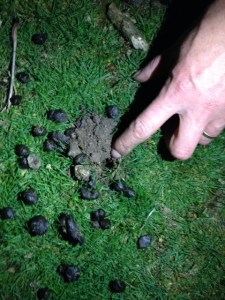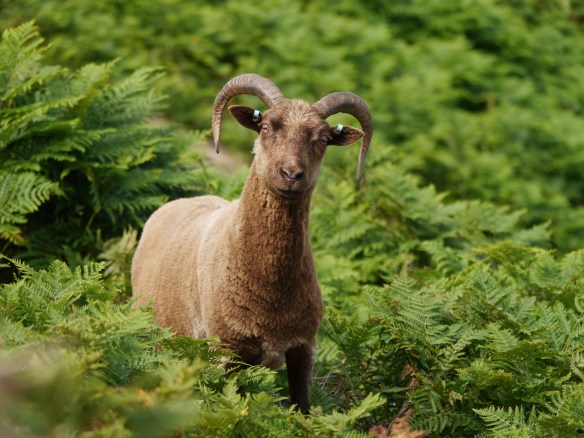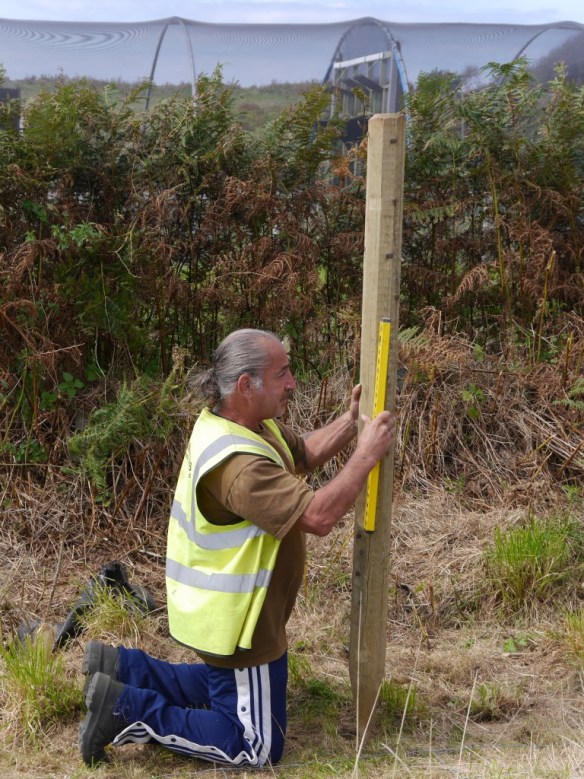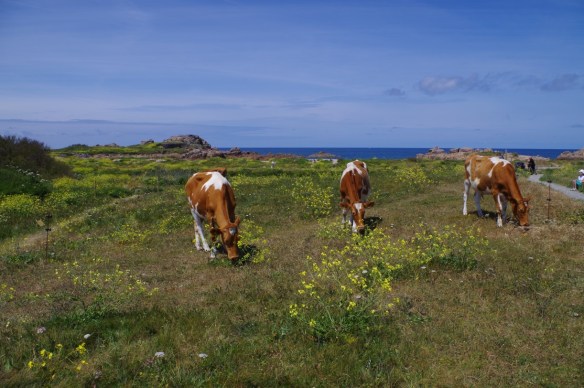Dung beetles belong to the group of insects called the Scarabaeoidea, which include dung beetles, chafer and stag beetles. There are just over one hundred species in the UK, of which over half are dung beetles. The National Recording Scheme for Scarabaeiodea has existed for many years, and has mostly been a data collection point and identification support to the recording community. As part of the on-going Species Status Project by Natural England in collaboration with Buglife, a review of the scarce and threatened dung beetles and chafers is currently in progress (to be published next year). This project highlighted the lack of modern records for many rare species and areas of the UK that were severely under recorded. This prompted us, Darren Mann (Head of Life Collections at the Oxford University  Museum of Natural History), Steve Lane, Ceri Watkins and myself (Sally-Ann Spence) to go out look for beetles in under-recorded areas and to re-survey sites where rare species were previously known. Together we set up the Dung beetle UK Mapping Project – affectionately abbreviated to DUMP and drawn attention to our project using the Twitter hashtags #dungathon and #dungisfun.
Museum of Natural History), Steve Lane, Ceri Watkins and myself (Sally-Ann Spence) to go out look for beetles in under-recorded areas and to re-survey sites where rare species were previously known. Together we set up the Dung beetle UK Mapping Project – affectionately abbreviated to DUMP and drawn attention to our project using the Twitter hashtags #dungathon and #dungisfun.
In addition to the fieldwork, we are examining museum collections to extract data for the historic distribution of species. We have put out a call to the beetle recording community, and data mined Irecord and Ispot. All of this data is building better distribution maps, informing habitat preferences and providing other ecological data for the UK dung beetle species. The end result will be a dataset of dung beetle information, including identification, distribution maps, ecology and species conservation status. This will be made available via The British Beetles website and will include an on-line recording system using Irecord.
Why we all need dung beetles
 Dung beetles are considered key Ecosystem Service Providers within the livestock sector. They deliver many benefits to farmers including increased soil nutrients and general nutrient recycling. They improve the soil structure by increasing aeration and drainage which in turn increases rain water filtration through the soil which also leads to a reduced run-off of rainfall – research is also looking at their pasture reseeding capabilities, abilities to reduce anaerobic processes and decrease methane formation. We know the process of pasture reseeding can have detrimental effects on soil erosion too.
Dung beetles are considered key Ecosystem Service Providers within the livestock sector. They deliver many benefits to farmers including increased soil nutrients and general nutrient recycling. They improve the soil structure by increasing aeration and drainage which in turn increases rain water filtration through the soil which also leads to a reduced run-off of rainfall – research is also looking at their pasture reseeding capabilities, abilities to reduce anaerobic processes and decrease methane formation. We know the process of pasture reseeding can have detrimental effects on soil erosion too.
They reduce pest flies, gastrointestinal parasites and pasture fouling by carrying fly egg and larval eating mites with them as well as consuming the dung the maggots live in themselves. Research is on-going into their part in nitrogen and carbon recycling but we know they are incredibly important in keeping pastures green and healthy for livestock especially in the absence of non-organic artificial fertilisers. Our results mapping the dung beetle species in the UK (although the project is in its youth), are already showing an alarming trend in species rarity and even extinction. The three main reasons behind this are considered to be the use of anthelmintics (especially in wormers), soil disturbance and the disappearance of livestock from historic pastures due to a change in farming practices.
 We take the opportunity of our survey visits to make farmers/livestock keepers aware of their dung beetles, the latest research, their economic benefits and how they might implement simple workable measures to ensure a healthy dung beetle population. We have received a fantastically positive response from all we have spoken to. Farmers are keen to preserve their dung beetles and we intend to gather more data about species and their population frequencies to enable more research into these incredibly important beetles.
We take the opportunity of our survey visits to make farmers/livestock keepers aware of their dung beetles, the latest research, their economic benefits and how they might implement simple workable measures to ensure a healthy dung beetle population. We have received a fantastically positive response from all we have spoken to. Farmers are keen to preserve their dung beetles and we intend to gather more data about species and their population frequencies to enable more research into these incredibly important beetles.
We are at present unfunded (please contact if interested in helping to fund this vital project) so as individuals we are surveying the whole of the UK in our spare time, on family holidays or around other work. It is a huge labour of dung beetle devotion. We are obsessives and dung is a big part of our lives. The project is vast. Different species live in or under different dung in different stages of decomposition on different soils at different altitudes at different times of the year. Dung quality is important too. We have become connoisseurs of fine dung. Not adverse to feeling the texture or giving it a good sniff (you can tell a lot about an animals health by its dung), we will examine it and the soil underneath meticulously for beetles. All data is noted on the spot – the date, GPS location, soil type, weather conditions, temperature, elevation, dung type, pasture quality and time spent in that locality surveying.
Dung beetles in Jersey

 On a recent trip to Jersey helping a colleague working on the Ice Age Project, I took the opportunity to contact the Roger Long of the Société Jersiaise to trace some historical specimens in their collection that I had become aware of through my research. Never to miss a chance I also managed to survey a few isolated locations and one of which was the area around Devils Hole. It was just awesome to encounter large areas of Minotaur beetle Typhaeus typhoeus burrows. These dung beetles like sheep and rabbit dung on light soils with short turf. The population in this area was extremely good and as it became dark the air hummed with them flying in on sheep dung. They fill their burrows with the dung for their larvae to feed on. The smaller Aphodius sphacelatus and Aphodius prodromus were also represented in good numbers. These Autumn emergence species feed in the dung itself. Excitingly I also found Aphodius affinis in this area. Another small dung beetle that feeds within the dung but is not found in the UK and is considered rare in France. It was also a first record for Jersey.
On a recent trip to Jersey helping a colleague working on the Ice Age Project, I took the opportunity to contact the Roger Long of the Société Jersiaise to trace some historical specimens in their collection that I had become aware of through my research. Never to miss a chance I also managed to survey a few isolated locations and one of which was the area around Devils Hole. It was just awesome to encounter large areas of Minotaur beetle Typhaeus typhoeus burrows. These dung beetles like sheep and rabbit dung on light soils with short turf. The population in this area was extremely good and as it became dark the air hummed with them flying in on sheep dung. They fill their burrows with the dung for their larvae to feed on. The smaller Aphodius sphacelatus and Aphodius prodromus were also represented in good numbers. These Autumn emergence species feed in the dung itself. Excitingly I also found Aphodius affinis in this area. Another small dung beetle that feeds within the dung but is not found in the UK and is considered rare in France. It was also a first record for Jersey.
 These dung beetles and their larvae are a vital part of food webs supporting many insectivorous birds and omnivorous mammals. The Minotaur beetles in particular are a important food resource for the choughs (see photo here) and it was excellent to see the sheep maintaining the right habitat for these beetles by their grazing behaviour and the dung they produced.
These dung beetles and their larvae are a vital part of food webs supporting many insectivorous birds and omnivorous mammals. The Minotaur beetles in particular are a important food resource for the choughs (see photo here) and it was excellent to see the sheep maintaining the right habitat for these beetles by their grazing behaviour and the dung they produced.
We hope to be back in Jersey in May 2016 to complete a whole Island dung beetle survey. This will provide a species list and population density records crucial for further research into Jersey’s precious ecosystems.
You can read about Sally-Ann’s Minibeast Mayhem – Educational Workshops here




















 he majority of resources were placed instead in monitoring the breeding success of our smaller bird populations. Over the course of two years we have seen an increase in the number of stonechat pairs, going from two to six and we have seen the cirl buntings, which returned in 2011, increase to two pairs. The breeding success of one of our most threatened birds, however, the turtle dove, proved difficult to confirm in 2014, although a single pair was seen nest-building. Skylarks seemed also to follow the negative trend of the last few years while lapwings remain at very low numbers, and are not able to reverse their decline of the last few years. In contrast, other small populations, such as that of the raven and the peregrine, do seem more stable at 3-5 breeding pairs.
he majority of resources were placed instead in monitoring the breeding success of our smaller bird populations. Over the course of two years we have seen an increase in the number of stonechat pairs, going from two to six and we have seen the cirl buntings, which returned in 2011, increase to two pairs. The breeding success of one of our most threatened birds, however, the turtle dove, proved difficult to confirm in 2014, although a single pair was seen nest-building. Skylarks seemed also to follow the negative trend of the last few years while lapwings remain at very low numbers, and are not able to reverse their decline of the last few years. In contrast, other small populations, such as that of the raven and the peregrine, do seem more stable at 3-5 breeding pairs.




















